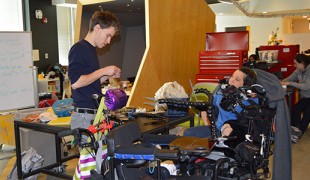- 3390
- 292
- 7
- 9
- 0
- Help Ukraine
About the solution
Despite Oskar playing games throughout his life, his father, Andreas Karlsson, regularly adapted standard controllers to meet his son’s needs.
“The GameCube controller was the first controller we adapted,” Andreas says. “We mounted screws in the joysticks and buttons and added polymorph around the screws. By doing that we could increase the length of the joysticks so it was easier to grip, and the increased length of the joysticks reduced the force required to maneuver it—but at the cost of range of movement. Taller joysticks mean longer movement—but at that point it worked because Mario Kart was kind of easy to control—unlike, let’s say, a fighting game like Street Fighter.”
As Oskar grew and his disability progressed, so too did the complexity of adaptive designs. As games evolved without proper accessibility features and options, Andreas struggled to discover tools that would allow his son to properly play. From adapters to eye-tracking devices, each piece of adaptive equipment failed to fully function and cost Andreas hundreds of dollars. Furthermore, the substitutes never matched the designs of standard controllers, amplifying the sense of difference that can accompany gaming as a disabled player, which left a young Oskar not wanting to game at all.
Even the Xbox Adaptive Controller, a device specifically designed for physically disabled players, couldn’t meet Oskar’s needs. As Andreas notes, the size and spacing of the controller and its varying switches and buttons meant that Oskar needed to exert even more energy to simply move his arms and hands to be able to reach the necessary buttons. But the size wasn’t the only issue. Since adaptive equipment can be a gamble for disabled players, each purchase may result in expensive pieces of plastic that cannot assist the needs of the specific individual.
Andreas then started years of hard work to search for an affordable and accessible controller for his son. After designing several devices while seeking outside assistance from charities and organizations, Andreas finally found help through 8BitDo. In 2022, 8BitDo, known for creating third-party controllers and adapters, announced its latest controller for the Nintendo Switch and Android devices. The Lite SE, created through collaborative efforts with father and son team Andreas and Oskar Karlsson, is designed specifically for physically disabled players with limited strength and mobility. The launch of this controller expands the market of accessible gaming tech.
The controller also costs only $34.99, an affordable option compared to other standard products featuring extra buttons or complementary joysticks. Oskar can now even play with the same skill level as his father, even surpassing him in some instances.
Adapted from: https://www.wired.com/story/andreas-karlsson-accessible-controller-8bitdo/, https://www.8bitdo.com/lite-se/
https://youtu.be/o5vhf26rwq8
这些解决方案不应包括使用药物,化学品或生物制品(包括食品);创伤性设备;冒犯性的,商业或内在危险的内容。该解决方案未经医学验证。请谨慎进行!如果您有任何疑问,请咨询健康专家。
DISCLAIMER: This story was written by someone who is not the author of the solution, therefore please be advised that, although it was written with the utmost respect for the innovation and the innovator, there can be some incorrect statements. If you find any errors please contact the patient Innovation team via info@patient-innovation.com
-
-
292
-
0
-
3390

Lite SE - worried father creates an affordable and accessible controller for his son with 8BitDo company
-
-
-
675
-
0
-
12203

Helmet with multifunction tip
Video gaming
Writing (letters, songs, peoms)
Cerebral Palsy
Assistive Technology access
Body-Worn solutions (Clothing, accessories, shoes, sensors...)
Tremors
Muscle cramps or spasms
Stiffness or rigidity (difficulty moving)
Muscle weakness
Trouble with fine motor skills (e.g., writing, buttoning clothes)
Promoting self-management
Managing Neurological Disorders
Promoting inclusivity and social integration
Caregiving Support
Neurology
Pediatrics
Portugal
-
-
-
340
-
0
-
4920

Woman with disability invents assistive technology
CAREGIVING
Grip
Cerebral Palsy
Assistive Technology access
Assistive Daily Life Device (to help ADL)
Tremors
Muscle cramps or spasms
Difficulty coordinating movements
Stiffness or rigidity (difficulty moving)
Paralysis of the legs and lower body
Muscle weakness
Trouble with fine motor skills (e.g., writing, buttoning clothes)
Twitching or involuntary movements (myoclonus)
Restoring mobility
Promoting self-management
Managing Neurological Disorders
Promoting inclusivity and social integration
Caregiving Support
Medical Genetics
Neurology
Rheumatology
United States
-
 zh
zh